With their small and still-developing bodies, newborn babies are some of the most vulnerable humans when it comes to the potential effects of toxic chemicals. Pound for pound, they breathe more air, drink more water, and eat more food than adults do. That’s why many parents are doing what they can to decrease the amount of toxins in their little one’s environment.
Plus, as we know, newborns spend most of their time sleeping! Many traditional bassinets and crib mattresses are made with things like petroleum-based memory foams and formaldehyde-heavy glues, which aren’t always great for a baby’s development.
That’s why in this article, we’re going to talk about the different sleeping options for your newborn and then give our recommendations for the best organic and non-toxic bassinets, Moses baskets, and co-sleepers.
RELATED: The best non-toxic cribs and organic crib mattresses
Table of Contents
- What Is a Moses Basket?
- What Is a Bassinet? (And What’s the Difference Between an Organic Baby Bassinet and a Crib?)
- Why Use An Organic/Non-Toxic Bassinet?
- 13 of the Best Organic & Non-Toxic Bassinets/Co-Sleepers For Your Baby
- Babyletto Gelato Portable Bassinet
- babybay Bedside Sleeper
- Finn + Emma Carry Cot
- OEUF Fawn + Crib Bassinet System
- Swahili African Modern Moses Basket
- Plum & Sparrow Moses Basket
- Monte Design Rockwell Bassinet
- Baby Delight Organic Snuggle Nest
- Baby Eco Trends
- Naturepedic Organic Mattresses
- Other Common Questions about Popular Bassinet Brands
- Do Babies Need A Bassinet, Co-Sleeper, or Moses Basket? (What To Consider When Shopping)
This post contains affiliate links, which means we may earn a small commission if you choose to make a purchase. We only make recommendations that are genuine and meet our ingredient/material standards.
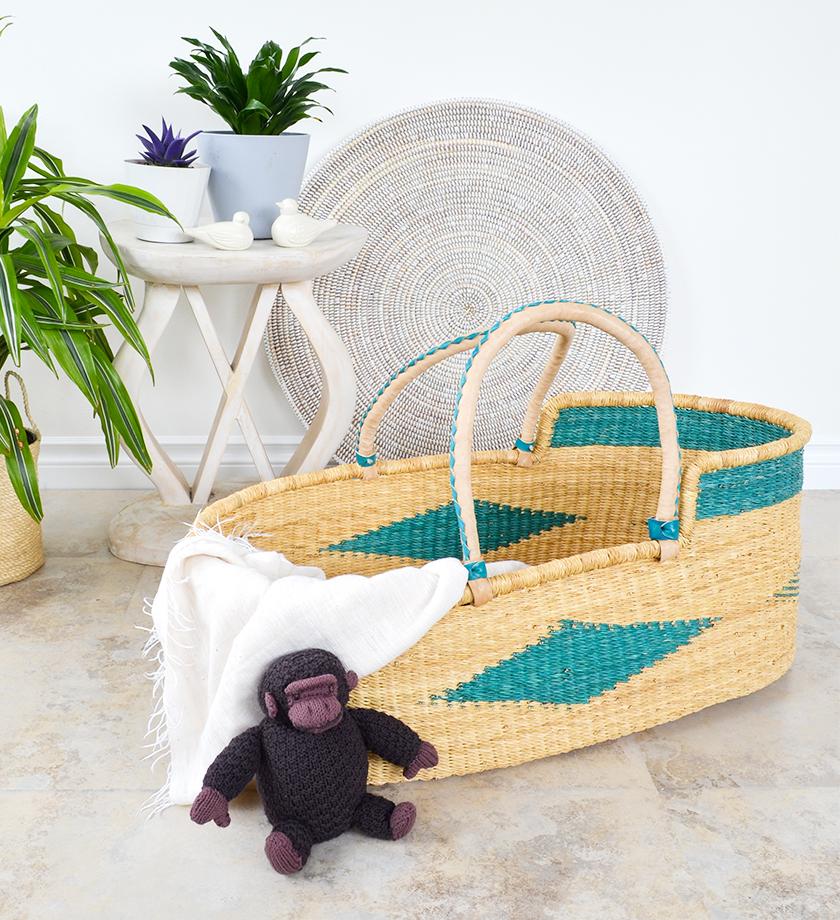
First, it’s helpful to be familiar with the different kinds of sleepers available for newborns…
What Is a Moses Basket?
Pictured above, a Moses basket is literally a basket that you can put your baby in. It’s long and narrow and has handles for easy portability. A lot of parents like Moses baskets because they’re so lightweight and easy to move around the house, so your newborn baby can be close by wherever you are.
Moses baskets are usually only used for babies up to about four months (give or take a few weeks depending on the length, weight, and mobility of the baby). You know your baby has outgrown their Moses basket when they begin to pull themself up, lift their head, and/or roll over. Moses baskets have weight limits too, which will vary by brand but are usually somewhere around 15 or 20 pounds.
If you choose to purchase a Moses basket, just make sure you follow the instructions that come with it in order to keep your baby safe at all times and use the correct size bassinet mattress (not too big or too small). We’ll talk more about the AAP’s guidelines for safe baby sleeping in a minute.
What Is a Bassinet? (And What’s the Difference Between an Organic Baby Bassinet and a Crib?)
Both cribs and bassinets are safe places for babies to sleep. Bassinets and Moses baskets are both smaller than a crib, so they might be a better choice for those with smaller living spaces. Cribs, however, will last longer as your baby grows.
According to the Consumer Product Safety Commission (CPCS), a bassinet or cradle is defined as a “small bed designed primarily to provide sleeping accommodations for infants that is supported by freestanding legs, a stationary frame/stand, a wheeled base or a rocking base, or that can swing relative to a stationary base.”
The main difference between a bassinet and a crib is size. Cribs can be “full-size” or “non-full size,” but both are bigger than bassinets.
What is a Co-Sleeper?
Co-sleeping (also called bed-sharing) is when parents bring their babies to their own bed with them. Co-sleeping can be dangerous and can increase the risk of sudden infant death syndrome (SIDS), especially in younger babies, due to potential suffocation by sheets, being crushed by mom or dad, falling off of the bed, etc.
Some parents choose to use a co-sleeper, which is a special baby bed that allows the baby to sleep with their parent, but in a safer way.
But are co-sleepers safe? The American Academy of Pediatrics (AAP) doesn’t actually make a recommendation one way or the other. They state, “The AAP cannot make a recommendation for or against the use of bedside sleepers or in-bed sleepers until more studies are done.” One of the reasons for this is likely because there are different types of co-sleepers, which have different levels of safety. Using the same term for these various baby bassinets can be a bit confusing.
So, let’s talk about the three main types of co-sleepers:
Nest and In-Bed Co-Sleepers
An in-bed co-sleeper involves a little nest that is put on the parent’s bed which has walls that separate the baby from its parents, extra bedding, etc. This type of co-sleeper is not recommended (it can still fall off the bed if you roll over and potentially cause other dangers).
Attached Co-Sleepers
Attached co-sleepers attach to the side of a parent’s bed. It makes it easier to bring a fussy baby over to your bed to breastfeed or rock them, but then scoot them back over into their own bed when it’s time to go back to sleep. These types of co-sleepers are probably safer than nest and in-bed co-sleepers, but they still aren’t necessarily recommended but the AAP at this time.
Freestanding Co-Sleepers
This is where it gets kind of confusing because “freestanding co-sleepers” and bassinets are pretty much the same thing. Sometimes the terms bassinet and co-sleeper are even used interchangeably.
But essentially, a freestanding co-sleeper is a completely separate bed for your baby, which is not touching the parent’s bed at all. It tends to be more portable than a crib. You can have it close by or right next to your bed, but doesn’t involve any bed-sharing. This is the type of sleeping arrangement that the AAP recommends for the first six months of a baby’s life.
Why Use An Organic/Non-Toxic Bassinet?
Babies’ small, developing bodies are especially vulnerable to the toxins in our environment—be it chemical flame retardants, plasticizers, and more. Many of these volatile organic chemicals (VOCs) that conventional furniture is made with are known endocrine disruptors (which means they can negatively alter hormones), carcinogens, or otherwise irritating.
It’s not uncommon for babies to struggle with things like eczema, so many parents are doing everything they can to decrease the amount of toxins their baby is exposed to in order to support their overall health.
There are two main components to consider when it comes to bassinet materials. The first is the cradle and/or frame portion. This can be made out of wood, plastic, woven grass, metal, or something else.
The second piece is the mattress. A lot of conventional mattresses are made with synthetic materials like polyurethane foam, polyester, and other plastics. These are petroleum byproducts and they’re not healthy for humans.
One could argue that making sure the mattress part of your baby’s bed is non-toxic and/or organic is the most important part because it’s what is right against your baby’s face and touching their skin. Look for materials like organic cotton or linen along with natural wood and woven grass. Also look for third-party certifications such as GOTS, MADE SAFE, GREEENGUARD, and CertiPUR.
Below we’re giving you options for both the frame and the mattress. You may get both pieces from the same brand or you may choose to mix and match, but if you do that, just make sure everything is the proper size in order to keep your baby safe.
What Are VOCs and What Is Off-Gassing?
As mentioned above, volatile organic compounds (VOCs) are commonly used in things like furniture. Many of them are human-made chemicals that often come in the form of things like foams, glues, and chemical flame retardants. Here is a list of several VOCs that are commonly found in things like bassinet mattresses:
- 1,3-butadiene
- benzene (also found in things like candles)
- formaldehyde
- methylene chloride
- tetrachloroethylene
- toluene
- xylene
If you want, you can read more about VOCs here.
A Bit of Good News
One thing to note is that flame retardants in children’s products have largely been outlawed in recent decades in certain localities, like California. Considering that most companies want to sell to customers in California, this has lead to a kind of de facto elimination of flame retardants in most bassinets, cribs, and crib mattresses. That means that even if you buy a bassinet from a more ‘conventional’ brand, it probably doesn’t have as much toxic chemicals as it used to!
13 of the Best Organic & Non-Toxic Bassinets/Co-Sleepers For Your Baby
The good news is that there are some great non-toxic bassinets, Moses baskets, and co-sleepers on the market that you can feel good using. There are definitely pros and cons to the different brands and specific products, and everyone will have their own preferences. But we’re giving you the info below so you can choose what’s best for you:
Babyletto Gelato Portable Bassinet
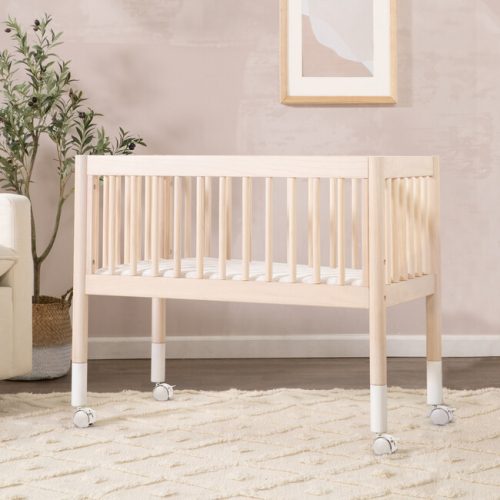
This non-toxic bassinet is bigger than a basket but is still pretty portable with its removable wheels. It’s made primarily out of solid New Zealand pine wood and carries a GREENGUARD Gold certification which means it’s been verified to emit a minimal amount of VOCs.
The bottom of this freestanding bassinet is the only part that uses MDF, but Babyletto has said it’s free of formaldehyde. This is most likely because it’s manufactured using a water-based adhesive that doesn’t use detectable levels of VOCs.
The Gelato does come with a mattress pad, but it’s not made with organic/natural materials, so you may want to swap it out for Naturepedic’s Organic Mini Crib Mattress.
Price: $229
Can use until: Baby reaches 17.5 lbs or can roll over
Also, check it out in Target.
babybay Bedside Sleeper
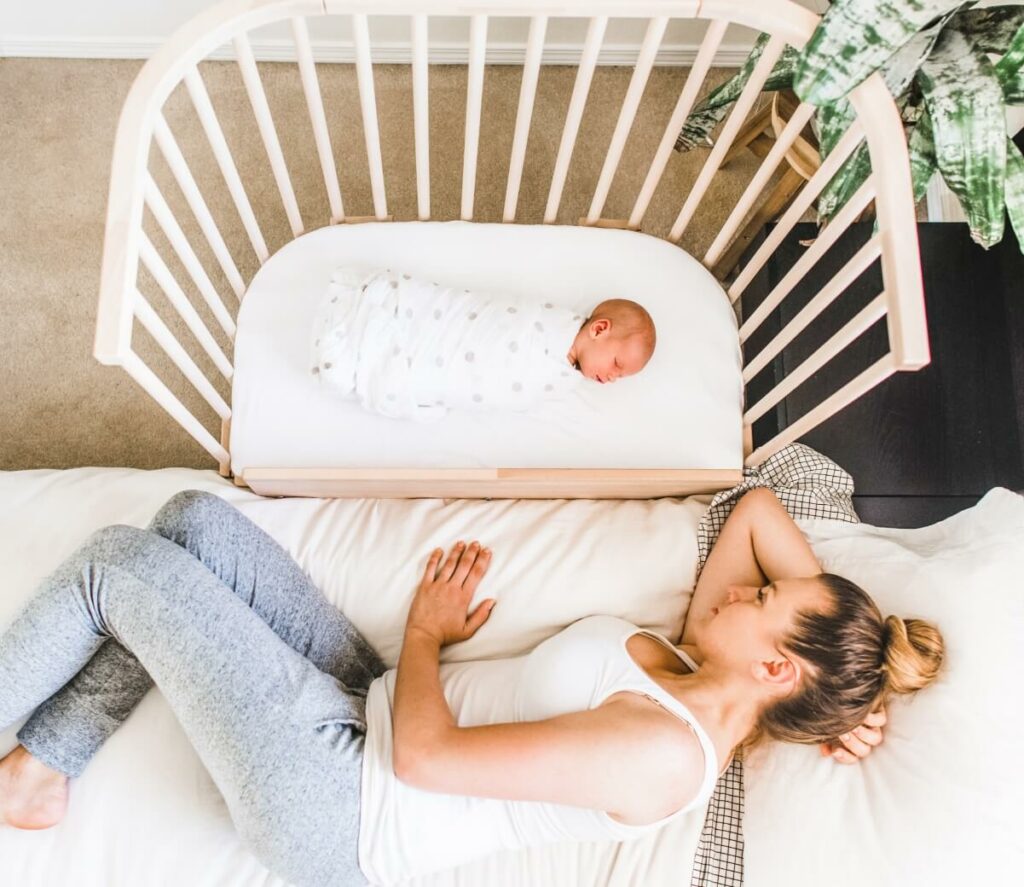
The babybay is a freestanding co-sleeper that’s made in Germany out of materials like solid beechwood (zero MDF) and water-based glues and finishes. (You also have an untreated option, pictured above, which does not have any finishes at all.)
One side of the sleeper has a shorter side to it so that you can push the bassinet up next to your bed while still making sure your baby is secure in their own space. Then you can purchase an optional side railing to convert the bassinet into a regular crib if you want to. You can get optional wheels as well. They also carry a taller version and a larger “maxi” version if you want a bigger one.
The only downside to this one is that they don’t offer an organic mattress pad to go with it (the mattresses are made primarily from polyurethane foam), and we haven’t been able to find any other brands that offer an organic mattress that’s the proper size and shape for the babybay bassinet. Of the three mattresses babybay offers, we recommend going with the “Classic” because it has the greatest amount of cotton. Then you can get the organic sheet set to go on top.
Price: $245+
Can use until: up to approximately 6 months of age or until baby pushes up
Finn + Emma Carry Cot
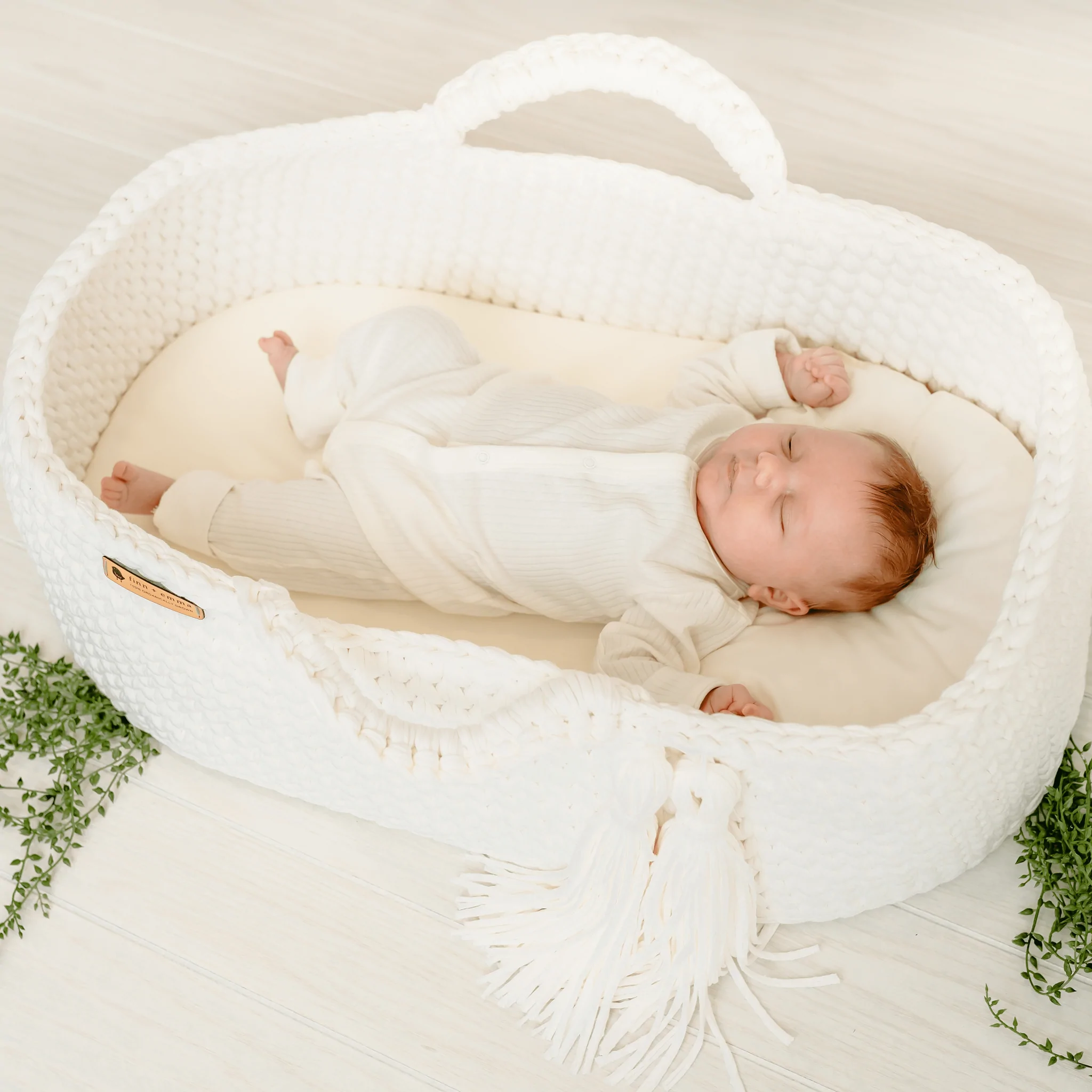
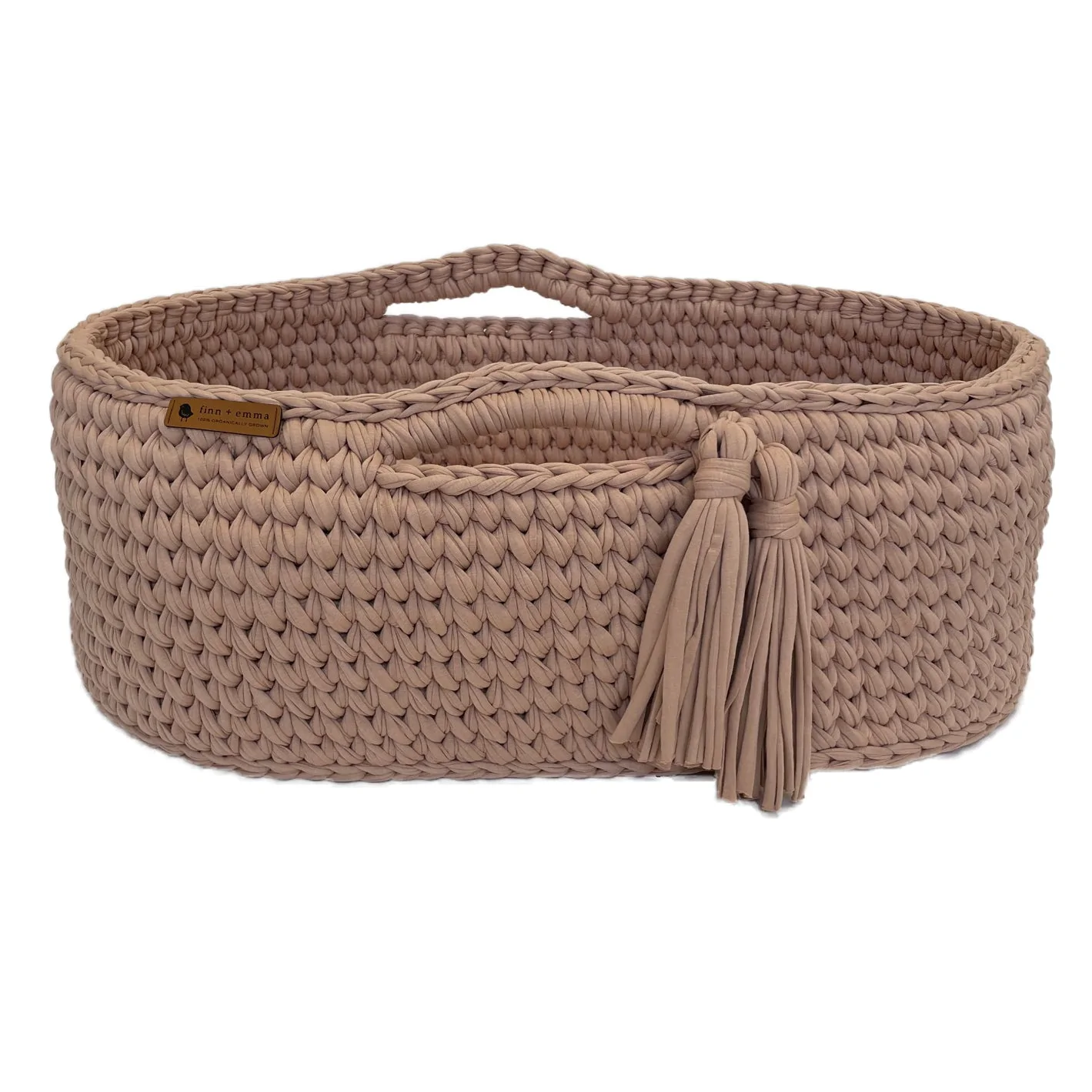
This Carry Cot is Finn + Emma’s “modern take on the class Moses basket.” It’s ethically made of super-soft organic cotton in a crocheted knit weave, and it features a removable mattress and pillow, as well as handles that make it easy to move.
Plus, these beautiful pastel colors look beautiful in the nursery or any room in your home. When your baby outgrows the cot, it can be used as a diaper basket, toy bin, etc.
Price: $179
Can use until: approximately 6 months
OEUF Fawn + Crib Bassinet System
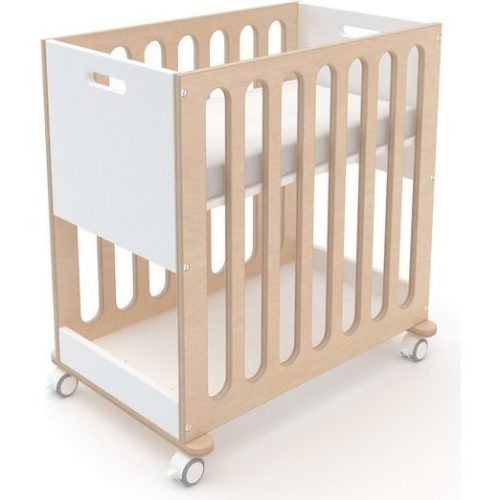
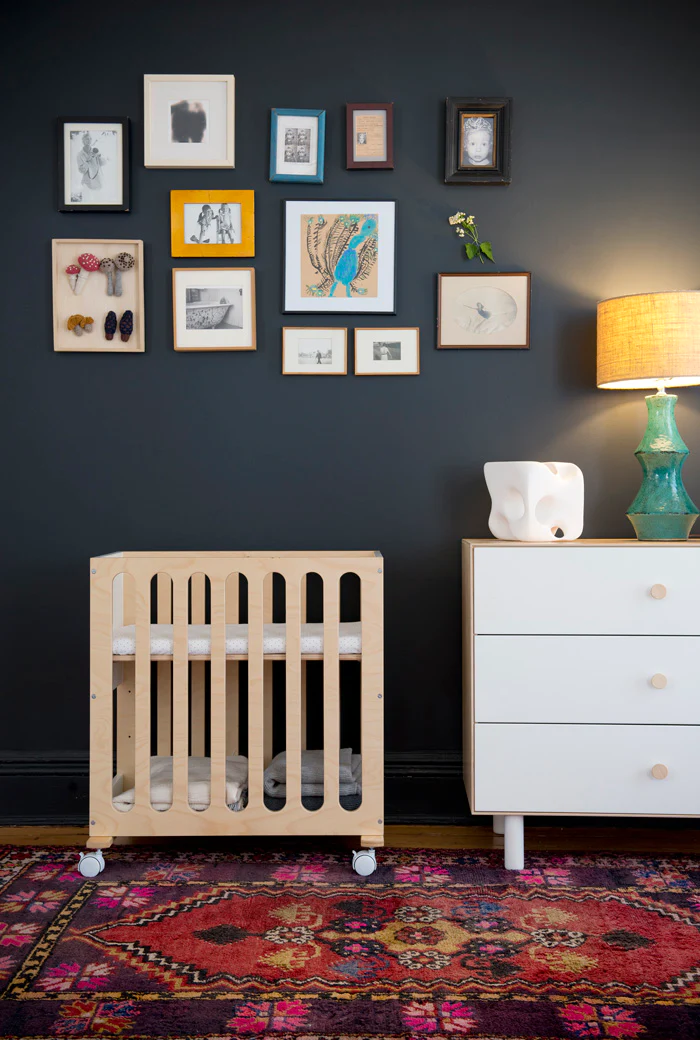
This is a pretty cool bassinet/crib 2-in-1 combo. The Fawn crib and bassinet system starts as a bassinet on wheels and can be converted into a full-sized crib as your baby grows. Then with the proper conversion kit, you can even turn it into a toddler bed, too. The modern, eco-friendly design is both practical and chic.
It is NOT completely free from plywood, but rather is made from FSC-certified Baltic birch plywood (eco-MDF) under European standards. It’s also made with water-based finishes and comes with a GREENGUARD Gold certification.
The bassinet comes with it’s own mattress pad, which is made out of a plant-based foam (not the best and not the worst material). Once you turn the bassinet into a crib, you have more options for the mattress—you can either grab one of OEUF’s (which are still made from partially plant-based foam) or you can replace it with a totally organic one from another brand.
Price: $1,085 (financing available)
Can use until: the child is a toddler (with proper conversion kits)
Swahili African Modern Moses Basket
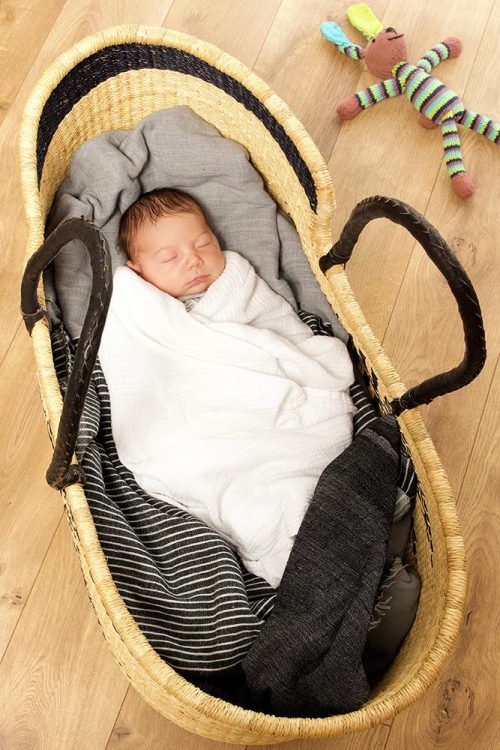
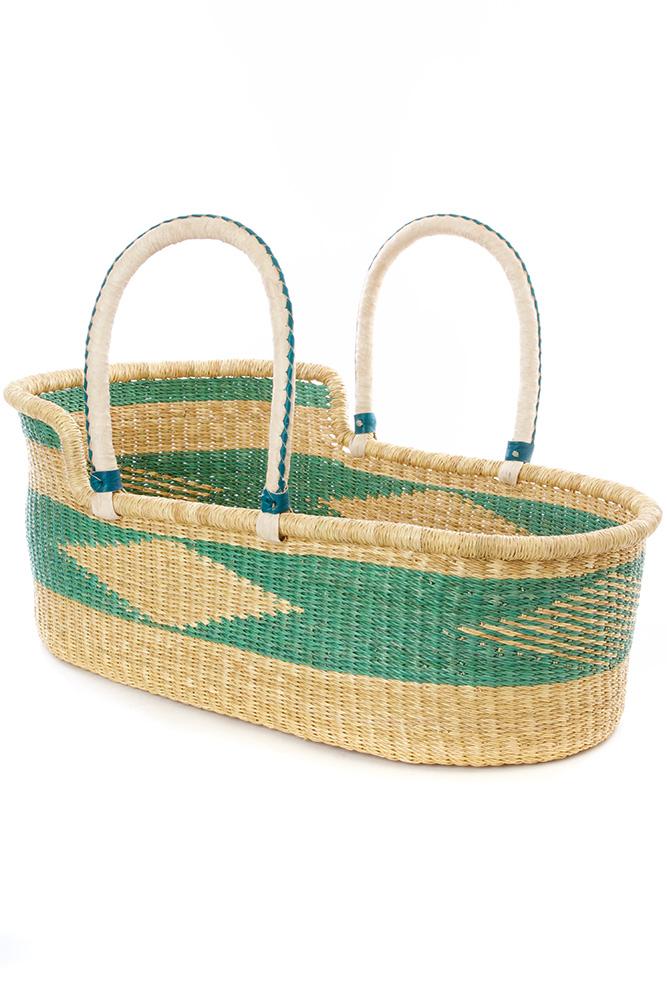
These Fair Trade Moses baskets are handwoven in Ghana using natural Elephant grass. Swahili African Modern showcases the brilliance of modern African design through a beautiful collection of artisan-crafted baskets (as well as hampers and other home decor), all of which is hand-woven by the Wolof women of Senegal who are traditional, artisan basket weavers.
Price: $168
Can use until: about 6 months
Plum & Sparrow Moses Basket
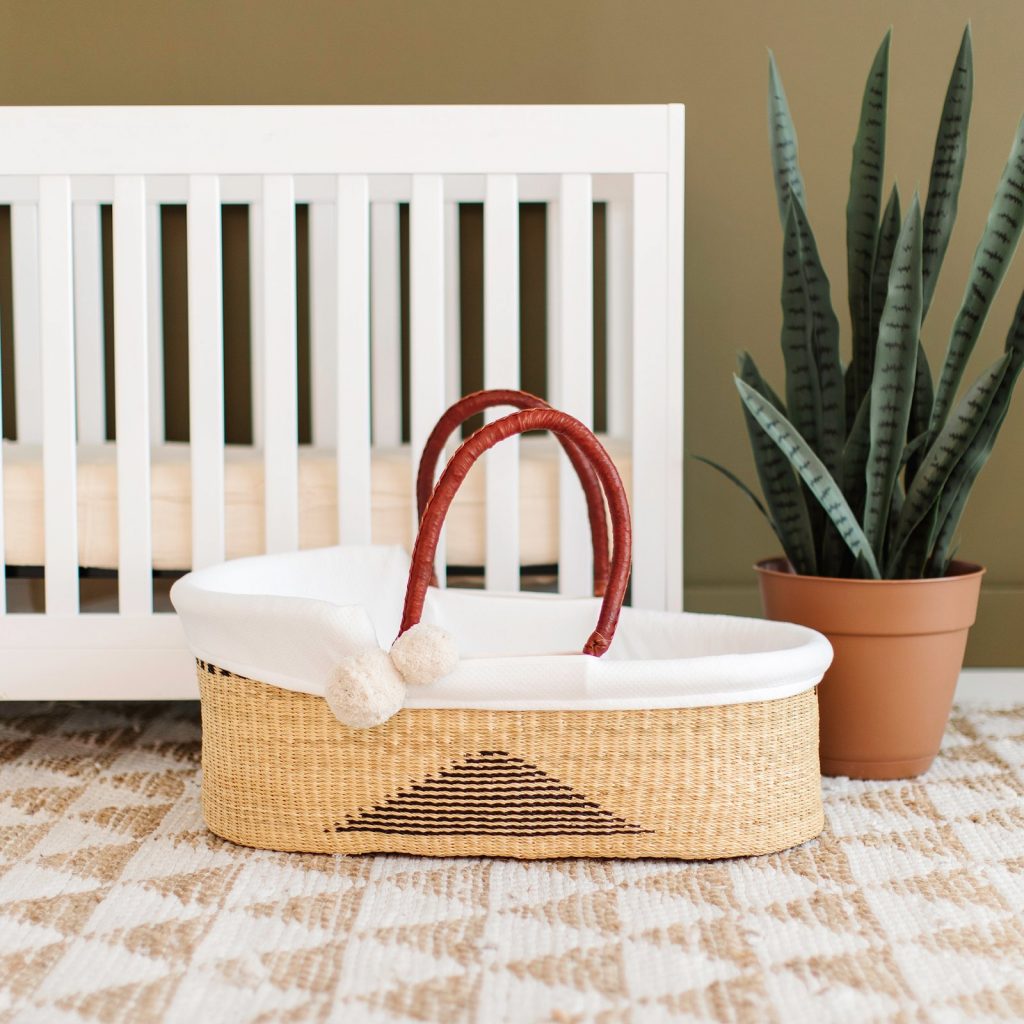
This brand also carries a wide variety of Moses baskets that come in a lot of different (beautiful!) designs and shapes. Everything is handwoven by their artisan partners in Africa who have passed the skill of basket weaving down for generations. They have mattresses, liners, and stands to go with them as well.
Price: $195
Can use until: baby starts to sit up or roll over on their own
Monte Design Rockwell Bassinet
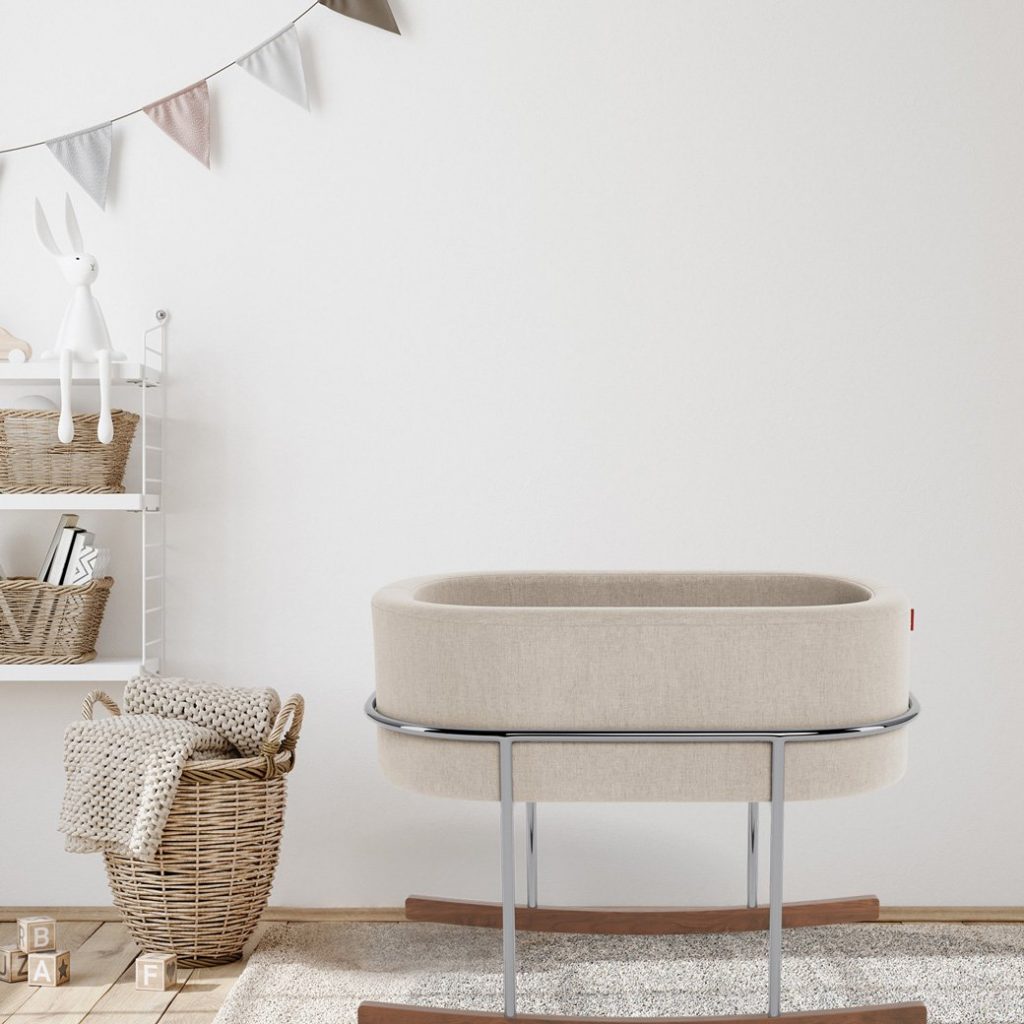
Monte Design makes a modern rocking bassinet. It’s not completely natural, but it’s handcrafted in Canada using CertiPUR certified, low-VOC foam. It carries an OEKO-TEX certification as well, which means the final product has been tested for a variety of toxic substances.
Unfortunately, the mattress that comes with this bassinet is not natural or organic either, but we will keep our eyes out for a natural alternative that fits with this bassinet.
Price: $695
Can use until: baby is 18 pounds or can roll over and move around
Baby Delight Organic Snuggle Nest
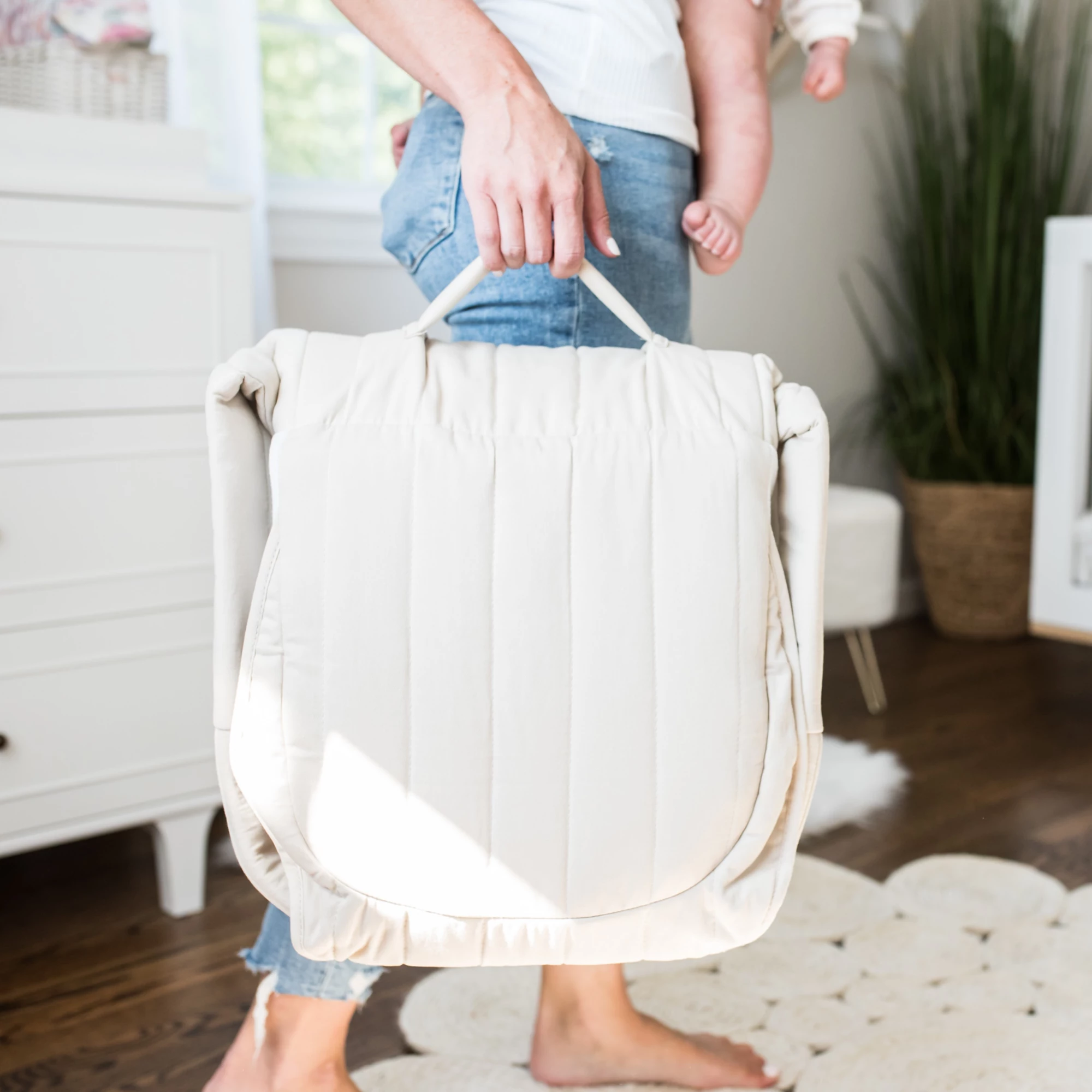
If you’re looking for something that can be folded up and tucked away into the closet or thrown in the car, this might be a good option for you. Baby Delight makes a portable infant sleeper that can be easily folded for storage. The mattress portion does contain synthetic foam, but the non-toxic fabric covering is made from GOTS organic cotton.
Price: $85
Can use until: baby is about 9 months
Baby Eco Trends
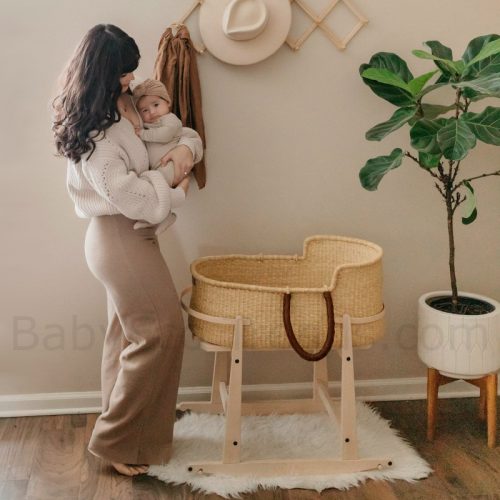
If you’re looking for a stand to go with your organic moses bassinet, this website carries lots of them. Many of them rock, which can be an added feature to help soothe your baby to sleep. They’re handmade in Georgia, USA out of solid hardwood and certified Asthma & Allergy-Friendly paint. You can buy locks and/or brakes for them, too. Just make sure you get the right size for your basket!
Price: $190-$210
Can use until: Varies by basket/stand size, so check individual product pages for details
Naturepedic Organic Mattresses
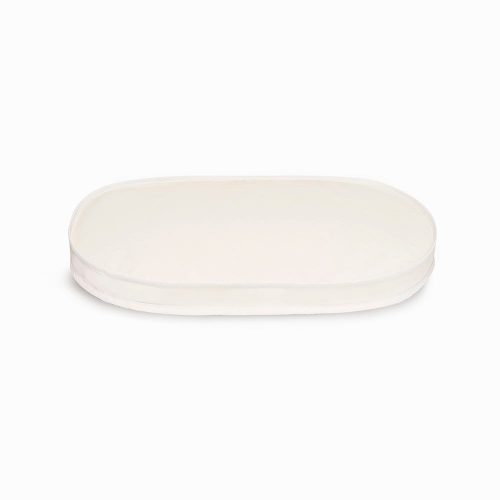
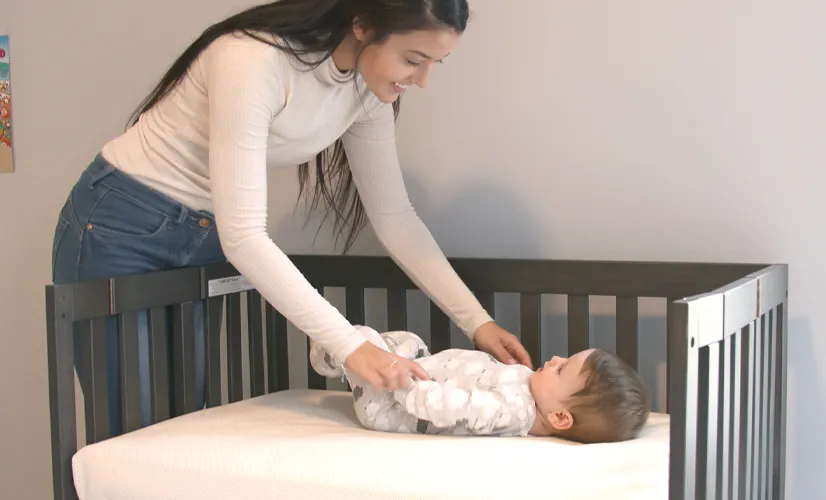
It can be difficult to find an organic bassinet mattress. Naturepedic is one of the most trusted companies when it comes to non-toxic mattresses. Unfortunately, they don’t carry bassinets, but they do carry a couple of stand-alone mattresses for babies, including an oval crib mattress, a mini crib mattress, changing table pads, and resting nap pads. (They also used to make a smaller oval bassinet pad which they unfortunately don’t manufacture anymore but you can still find it carried by some online retailers.)
If you already have a bassinet, co-sleeper, or Moses basket that will fit these dimensions then it might be a great addition to your current setup. (Again, just make sure it’s exactly the right size!) This mattress comes with a whole handful of safety certifications, including MADE SAFE, GOTS organic, and GREENGUARD.
Use code thefiltery15 for 15% off.
Other Common Questions about Popular Bassinet Brands
Is SNOO Mattress Organic?
SNOO is a popular brand that advertises itself as a “virtual babysitter” by providing sleep sounds and robotic gentle rocking motion for your baby. Unfortunately, SNOO is not transparent about their materials, so we can’t really recommend it. (The fitted sheet and sleep sacks, however, are made from GOTS organic cotton—so at least that’s something!)
It may also be worth nothing that because the SNOO is a smart device, it comes with extra EMFs. Parents who want to take a precautionary approach to the EMF issue may choose to stay away from this bassinet for that reason as well.
Is the Halo Bassinet Non-Toxic?
Halo is another popular bassinet brand; depending on which version you get, your sleeper can swivel or vibrate to soothe your baby. But what are they made out of? According to Halo’s website, “the bed portion of the BassiNest Swivel Sleeper is made from 100% polyester fabric. The fitted sheet is a soft polyester knit. The base portion is made from steel, aluminum and high-impact plastic.” They go on to say that “all the plastic and paints used on BassiNest are lead, phthalate, and BPA-free.”
They do use chemical flame retardants in their bassinet mattresses as well, which is not good. (Thank you to reader Rachel for getting this info from them!)
Is BabyBjorn’s Bassinet Safe?
According to their website, BabyBjorn’s Baby Cradle “is tested and approved according to the safety standard EN 1130. It stands firmly on the floor and has sturdy anti-slip feet. The airy mesh fabric makes the cradle cool and safe and also gives you good supervision of your little one.” So from a functional standpoint, the BabyBjorn bassinet is safe.
When it comes to the materials, BabyBjorn’s bassinet cradle is okay, but not great. It’s made from things like polyester, MDF, beechwood, polyether foam, and more polyester and PU foam. The only thing that’s really going for it is that it’s OEKO-TEX certified, which is definitely better than nothing.
Do Babies Need A Bassinet, Co-Sleeper, or Moses Basket? (What To Consider When Shopping)
There are several different things to consider when choosing what type of sleeping situation is best for you and your baby:
Portability
Especially when babies are very new, you want to be able to keep an eye on them all the time. Moses baskets are super portable and can easily be moved from room to room (although, you should never carry a Moses basket by the handle with the baby actually in it). The portability of bassinets varies by type and brand, but they’re definitely more portable than cribs.
Home & Bedroom Size
The next thing to consider is the size of your home and bedroom. Moses baskets don’t take up very much space, whereas cribs tend to take up a lot more space. You might not have room for a crib in your bedroom for the first six months of your baby’s life, so a basket or bassinet might work a lot better for you.
Breathability
Many bassinets have breathable mesh sides, which allow for airflow. Not only can they help keep your baby from getting too hot, but if they roll over and end up with their face against the side of the bassinet, they will still be able to breathe. Most of this mesh is nylon, which is a synthetic material. When it comes to toxicity, though, it’s not the best or the worst material. This is a situation where it’s worth using synthetic material in order to guarantee airflow.
Stability
Whatever product you choose, make sure it has a smooth bottom and a wide base so that it’s sturdy and cannot be knocked over.
What Are The AAP’s Safe Sleep Guidelines?
Regardless of whether you use a bassinet, Moses basket, or crib, the American Academy of Pediatrics (AAP) has a set of safety guidelines that should be applied across the board. Here are some of them:
- Place your baby to sleep in the same room where you sleep but not the same bed. Room share with the baby until at least six months of age.
- Keep soft objects, loose bedding, or any objects that could increase the risk of entrapment, suffocation, or strangulation out of the crib. This includes extra bedding, stuffed animals, bumper pads, comforters, etc.
- Place your baby to sleep on its back for every sleep.
- Do not use sleep positioners, wedges, or other types of sleeping aides.
- Place your baby to sleep on a firm, flat sleep surface.
- Do not let your baby get too hot.
Important Note: Always Use Correctly-Sized Accessories
Most brands that make baskets and bassinets also make mattresses and fitted sheets that fit the exact dimensions of the bed. This is very important because a mattress that is too big or too small can cause infants to suffocate. Using extra sheets or blankets can also lead to suffocation, so always make sure you’re using correctly sized mattresses and fitted sheets, and do not use any extra bedding.
The safety guidelines listed here are not extensive. Be sure to read and follow all of the AAP’s safety guidelines and talk to your OB/GYN before bringing your sweet baby home for the first time.
Your baby spends the majority of its new life sleeping, so you can feel good about choosing from this list of the best non-toxic bassinets for your new little love. To get more guides and tips delivered to your inbox once a week, sign up for Filtered Fridays.





I have reached out to Halo basinet and the told me they do use chemical flame retardant in their bassinet mattress. just a heads up.
…actually, Babyletto’s site doesn’t list mattress components at all, but they say the cover is waterproof.
How do you think Babybay measures up with their bedside bassinet? The base of the Babyletto bassinet is MDF and although they say it is free of formaldehyde, I am still skeptical. They also have polyester in the mattress which I have read is not good??? IDK, it is all very overwhelming.
Thank you for this informative article. I’m trying to order the Snuzpod but so far I haven’t found anyone selling it in the US. Does anyone know if the Beaba or Venice Child are safe bedside sleeper options? Thank you
Hi Toby,
Did you by chance reach out to Snuzpod to ask how much it would be to ship to the US? Their website says they do ship the States.
I hope that at some point in my lifetime I will be able to see affordability in products like these, but the U.S. has to make changes before that will ever happen.
Agreed!
I have ordered from Wholesome Linen due to the recommendation from this blog post. I have to say that I do not recommend ordering from Wholesome Linen. I ordered $300 worth of items and I never received them. I have contacted the company through calls and emails. The do not answer their calls, so I have to leave messages and they never call back. They were answering my emails in which they would keep telling me to wait for the items they have been shipped. However, it’s been 3 months and I never got them and they refuse to do anything about it. They started ignoring my emails too. I have filed a complaint with the Better Business Bureau and found out that I was not the only customer that this happened to, so buyers please be ware!
Oh, no… We’re so sorry to hear about your experience with Wholesome Linen. Thank you for sharing with us – we’ve removed them from this article!